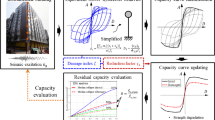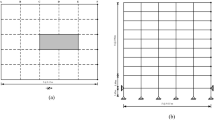Abstract
Current post-earthquake assessment relies on manual inspections to assess the safety conditions of existing buildings. Such field inspection in a building-to-building manner remains challenging as it is labor-intensive and relatively inefficient, which may affect the associated post-earthquake management plan and the economic loss. A simulation-based rapid performance evaluation of buildings is, therefore, needed. This study proposes a seismic performance evaluation framework for the frame structures with the aid of local ground-motion measurements, prior-event field testing, and time-history analysis. The linear behavior of the SDOF model is calibrated by the dynamic properties determined from dynamic tests under ambient vibration. When an earthquake happens, the peak spectral displacement of the building is estimated using the calibrated SDOF model via a time-history analysis. The feasibility and accuracy of the proposed method are validated using the data and inspection results collected from the Van Nuys hotel under Whitter, Landers, BigBear, and Northridge earthquakes. Results reveal that the proposed method can estimate the peak displacement with a favorable agreement. The proposed method is further applied to assess the conditions of thirty-five frame structures under earthquakes those happened from January 2019 to April 2022, in Gongxian city, Sichuan province.















Similar content being viewed by others
References
Zhao B, Taucer F, Rossetto T (2009) Field investigation on the performance of building structures during the 12 May 2008 Wenchuan earthquake in China. Eng Struct 31(8):1707–1723. https://doi.org/10.1016/j.engstruct.2009.02.039
Chang CM, Chou JY (2018) Damage detection of seismically excited buildings based on prediction errors. J Aerosp Eng 31(4):04018032. https://doi.org/10.1061/(ASCE)AS.1943-5525.0000835
Applied Technology Council (ATC) (1995). ATC-20–2 addendum to the ATC-20 postearthquake building safety evaluation procedures, Redwood City, California.
Roohi M, Hernandez EM (2020) Performance-based post-earthquake decision making for instrumented buildings. J Civil Struct Health Monit 10(5):775–792. https://doi.org/10.1007/s13349-020-00416-1
National Association of Home Builders (NAHB) Research Center (1994). Assessment of damage to residential buildings caused by the Northridge earthquake, United States Department of Housing and Urban Development Office of Policy Development and Research, Washington, DC.
Ghahari SF, Abazarsa F, Ghannad MA, Taciroglu E (2013) Response-only modal identification of structures using strong motion data. Earthq Eng Struct Dyn 42(8):1221–1242. https://doi.org/10.1002/eqe.2268
Kusunoki K (2021) Damage assessment in Japan and potential use of new technologies in damage assessment. In: Akkar Sinan, Ilki Alper, Goksu Caglar, Erdik Mustafa (eds) Advances in assessment and modeling of earthquake loss. Springer International Publishing, Cham, pp 27–46
Tena-Colunga A, Hernández-Ramírez H, Godínez-Domínguez EA, Pérez-Rocha LE (2021) Mexico City during and after the September 19, 2017 earthquake: Assessment of seismic resilience and ongoing recovery process. J Civil Struct Health Monit 11(5):1275–1299. https://doi.org/10.1007/s13349-021-00511-x
Chinese Earthquake Administration (2016). Earthquake prevention and disaster mitigation planning (2016–2020), National Development and Reform Commission of the People's of China, Beijiing. (in Chinese).
Kamat VR, El-Tawil S (2007) Evaluation of augmented reality for rapid assessment of earthquake-induced building damage. J Comput Civil Eng 21(5):303–310. https://doi.org/10.1061/(ASCE)0887-3801(2007)21:5(303)
Narazaki Y, Hoskere V, Chowdhary G, Spencer BF (2022) Vision-based navigation planning for autonomous post-earthquake inspection of reinforced concrete railway viaducts using unmanned aerial vehicles. Automat Constr. 137:104214. https://doi.org/10.1016/j.autcon.2022.104214
Lantada N, Pujades LG, Barbat AH (2008) Vulnerability index and capacity spectrum based methods for urban seismic risk evaluation. Compar Nat Hazards 51(3):501. https://doi.org/10.1007/s11069-007-9212-4
Vamvatsikos D, Allin CC (2006) Direct estimation of the seismic demand and capacity of oscillators with multi-linear static pushovers through IDA. Earthq Eng Struct Dyn 35(9):1097–1117. https://doi.org/10.1002/eqe.573
Lu X, Cheng Q, Xu Z, Xu Y, Sun C (2019) Real time city scale time history analysis and its application in resilience oriented earthquake emergency responses. Appl Sci 9(17):3497. https://doi.org/10.3390/app9173497
Pepe V, De Angelis A, Pecce MR (2019) Damage assessment of an existing RC infilled structure by numerical simulation of the dynamic response. J Civil Struct Health Monit 9(3):385–395. https://doi.org/10.1007/s13349-019-00340-z
Irizarry J, Lantada N, Pujades LG, Barbat AH, Goula X, Susagna T, Roca A (2011) Ground-shaking scenarios and urban risk evaluation of Barcelona using the Risk-UE capacity spectrum based method. Bull Earthq Eng 9(2):441–466. https://doi.org/10.1007/s10518-010-9222-6
Xiong C, Lu X, Lin X, Xu Z, Ye L (2017) Parameter determination and damage assessment for THA-based regional seismic damage prediction of multi-story buildings. J Earthq Eng 21(3):461–485. https://doi.org/10.1080/13632469.2016.1160009
Lu X, McKenna F, Cheng Q, Xu Z, Zeng X, Mahin SA (2020) An open-source framework for regional earthquake loss estimation using the city-scale nonlinear time history analysis. Earthq Spectra 36(2):806–831. https://doi.org/10.1177/8755293019891724
Reuland Y, Lestuzzi P, Smith IFC (2019) An engineering approach to model-class selection for measurement-supported post-earthquake assessment. Eng Struct 197:109408. https://doi.org/10.1016/j.engstruct.2019.109408
Bedon C, Santi MV, Fasan M (2022) Considerations on efficient procedural steps for seismic capacity assessment and diagnostics of historic structural glass systems. Soil Dyn Earthq Eng. 163:107562. https://doi.org/10.1016/j.soildyn.2022.107562
Miraglia G, Lenticchia E, Surace C, Ceravolo R (2020) Seismic damage identification by fitting the nonlinear and hysteretic dynamic response of monitored buildings. J Civil Struct Health Monit 10(3):457–469. https://doi.org/10.1007/s13349-020-00394-4
Giordano PF, Limongelli MP (2022) The value of structural health monitoring in seismic emergency management of bridges. Struct Infra Eng 18(4):537–553. https://doi.org/10.1080/15732479.2020.1862251
Jana D, Nagarajaiah S, Yang Y, Li S (2022) Real-time cable tension estimation from acceleration measurements using wireless sensors with packet data losses: analytics with compressive sensing and sparse component analysis. J Civil Struct Health Monit 12(4):797–815. https://doi.org/10.1007/s13349-021-00526-4
Chatzi EN, Smyth AW, Masri SF (2010) Experimental application of on-line parametric identification for nonlinear hysteretic systems with model uncertainty. Struct Saf 32(5):326–337. https://doi.org/10.1016/j.strusafe.2010.03.008
Shan J, Zhang H, Shi W, Lu X (2020) Health monitoring and field-testing of high-rise buildings: a review. Struct Concrete 21(4):1272–1285. https://doi.org/10.1002/suco.201900454
Lei Y, Zhang Y, Mi J, Liu W, Liu L (2020) Detecting structural damage under unknown seismic excitation by deep convolutional neural network with wavelet-based transmissibility data. Struct Health Monit 20(4):1583–1596. https://doi.org/10.1177/1475921720923081
Shan J, Shi W, Lu X (2016) Model-reference health monitoring of hysteretic building structure using acceleration measurement with test validation. Comput-Aided Civ Inf Eng 31(6):449–464. https://doi.org/10.1111/mice.12172
Cancelli A, Laflamme S, Alipour A, Sritharan S, Ubertini F (2019) Vibration-based damage localization and quantification in a pretensioned concrete girder using stochastic subspace identification and particle swarm model updating. Struct Health Monit 19(2):587–605. https://doi.org/10.1177/1475921718820015
Ditommaso R, Iacovino C, Auletta G, Parolai S, Ponzo FC (2021) Damage detection and localization on real structures subjected to strong motion earthquakes using the curvature evolution method: the Navelli (Italy) case study. Appl Sci 11(14):6496. https://doi.org/10.3390/app11146496
Park HS, An JH, Park YJ, Oh BK (2020) Convolutional neural network-based safety evaluation method for structures with dynamic responses. Expert Syst Appl. 158:113634. https://doi.org/10.1016/j.eswa.2020.113634
Federal Emergency Management Agency (FEMA) (2020). HAZUS Earthquake Model Technical Manual, Hazus 4.2 SP3.
Kusunoki K, Hinata D, Hattori Y, Tasai A (2018) A new method for evaluating the real-time residual seismic capacity of existing structures using accelerometers: Structures with multiple degrees of freedom. Jpn Archit Rev 1(1):77–86. https://doi.org/10.1002/2475-8876.1010
Shan J, Gong Y, Liu J, Shi W, Zhang H (2022) Damage tracking and evaluation of RC columns with structural performances by using seismic monitoring data. Bull Earthq Eng 20(9):4561–4587. https://doi.org/10.1007/s10518-022-01396-x
Pan TC, Goh KS, Megawati K (2014) Empirical relationships between natural vibration period and height of buildings in Singapore. Earthq Eng Struct Dyn 43(3):449–465. https://doi.org/10.1002/eqe.2356
Mazzoni S, Mckenna F, Scott MH, Fenves GL (2006) Open system for earthquake engineering simulation user command-language manual. University of California, Berkeley, Pacific Earthquake Engineering Research Cente
Ryu H, Luco N, Baker JW, Karaca E (2008). Converting HAZUS capacity curves to seismic hazard-compatible building fragility functions: effect of hysteretic models, The 14th World Conference on Earthquake Engineering, Beijing, China, pp. 12–17
Nafeh AMB, O’Reilly GJ, Monteiro R (2020) Simplified seismic assessment of infilled RC frame structures. Bull Earthq Eng 18(4):1579–1611. https://doi.org/10.1007/s10518-019-00758-2
Yu X, Li S, Lu D, Tao J (2020) Collapse capacity of inelastic single-degree-of-freedom systems subjected to mainshock-aftershock earthquake sequences. J Earthq Eng 24(5):803–826. https://doi.org/10.1080/13632469.2018.1453417
China Academy of Building Research (2015). Specification of testing methods for earthquake resistant building: GJ101/T2015.,
Todorovska MI, Trifunac MD (2008) Impulse response analysis of the Van Nuys 7-storey hotel during 11 earthquakes and earthquake damage detection. Struct Control Health Monit 15(1):90–116. https://doi.org/10.1002/stc.208
USGS, CGS, ANSS (2015). Center for Engineering Strong-Motion Data (CESMD), http://strongmotioncenter.org/aboutcesmd.html. (assessed 30 July 2022).
Ibarra L, Krawinkler H (2011) Variance of collapse capacity of SDOF systems under earthquake excitations. Earthq Eng Struct Dyn 40(12):1299–1314. https://doi.org/10.1002/eqe.1089
Bedon C, Noè S (2022) Rapid safety assement and experimental derivation of damage indexes for in-service glass slabs. Challenging Glass Conference Proceedings. 8, Blis, Bos and Louter.
Wang JF, Lin CC, Yen SM (2007) A story damage index of seismically-excited buildings based on modal frequency and mode shape. Eng Struct 29(9):2143–2157. https://doi.org/10.1016/j.engstruct.2006.10.018
Doulatabadi PR (1997). Three-dimensional nonlinear dynamic seismic behaviour of a seven story reinforced concrete building, Retrospective Theses and Dissertations, University of British Columbia, Columbia.
Goel RK, Chopra AK (1997) Period formulas for moment-resisting frame buildings. J Struct Eng 123(11):1454–1461. https://doi.org/10.1061/(ASCE)0733-9445(1997)123:11(1454)
GB50009-2012 (2012) Load code for the design of building structures. China Architecture and Building Press, Beijing
ASCE (2016). Minimum design loads for building and other structures, ASCE/SEI Standard 7–16,
Eurocode 8 (2005). Design of structures for earthquake resistance-part 1: general rules, seismic actions and rules for buildings, EN 1998–1, 2004. Brussels: Comité Européen de Normalisation,
Acknowledgements
This study is sponsored by the National Natural Science Foundation of China (Grant: 51878483, 52278312), the Shanghai Rising-Star program (Grant: 20QC1400700), the Shanghai Qi Zhi Institute (Grant: SYXF0120020109), the Peak Discipline Construction Project of Shanghai (Grant: 2021-CE-03), and the Shanghai Municipal Science and Technology Major Project (Grant: 2021SHZDZX0100).
Author information
Authors and Affiliations
Corresponding author
Ethics declarations
Conflict of interest
The authors declare that they have no known competing financial interests or personal relationships that could have appeared to influence the work reported in this paper.
Additional information
Publisher's Note
Springer Nature remains neutral with regard to jurisdictional claims in published maps and institutional affiliations.
Rights and permissions
Springer Nature or its licensor (e.g. a society or other partner) holds exclusive rights to this article under a publishing agreement with the author(s) or other rightsholder(s); author self-archiving of the accepted manuscript version of this article is solely governed by the terms of such publishing agreement and applicable law.
About this article
Cite this article
Shan, J., Wang, L., Loong, C.N. et al. Rapid seismic performance evaluation of existing frame structures using equivalent SDOF modeling and prior dynamic testing. J Civil Struct Health Monit 13, 749–766 (2023). https://doi.org/10.1007/s13349-023-00677-6
Received:
Accepted:
Published:
Issue Date:
DOI: https://doi.org/10.1007/s13349-023-00677-6




